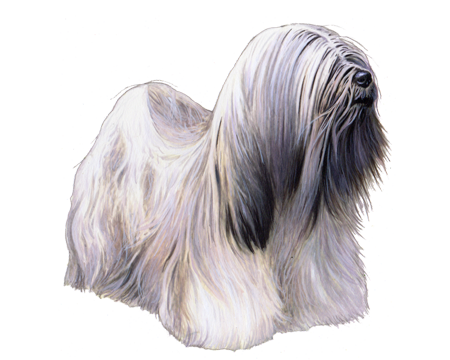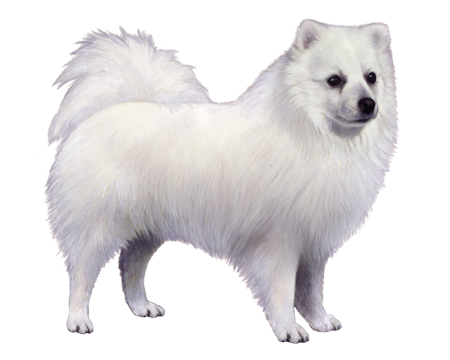
Lhasa Apso
Lhasa Apsos are smart, sensitive, and outgoing dogs. Their fearless personalities and keen sense of hearing make these small-but-confident dogs popular guardians. They will alert their owners at the first signs of trouble (or the mailman).
Interested in discovering if your dog is a Lhasa Apso?
Check out Wisdom Panel's DNA tests.

Lhasa Apso Traits
General Appearance
Lhasa Apsos are small, well-balanced, rectangular-shaped dogs. True to their Tibetan heritage, the breed is said to have aristocratic bearings, a thoughtful expression, and a smooth, effortless gait.
Coat and Coloring
This double-coated breed has heavy and straight—but not woolly or silky—long hair. All colors are acceptable and common coloring includes black, black and tan, cream, golden, grizzle, red, red gold, and white.
Distinctive Physical Traits
Lhasa Apsos have dark brown, almond-shaped eyes, pendular, heavily feathered ears, and well-feathered tails that are set high and carried over their backs, curling to the sides.
Other notable traits are the Lhasa's head furnishings—longer hair that falls over their eyes—and their cute beard and whiskers.
Lhasa Apso Temperament
Lhasa Apsos have regal attitudes that make them appear both elegant and serious. These dogs are outgoing, comical, and charming with their owners.
Thanks to their watchdog roots, Lhasas require socialization to reduce or prevent their aggressive tendencies. Because they're alert and want to protect their people, they often bark if something strikes them as a potential danger. Training can help them tell the difference between typical household sounds and noises that could signal trouble. If well-trained, they can be quiet, respectful apartment dogs.
Their confident, outgoing personalities make Lhasas great therapy dogs. They're good with children and other pets. However, they need supervision around young children and big dogs due to their small size.
These independent dogs rarely suffer from separation anxiety, making them excellent companions for people who work during the day.


Lhasa Apso History
The Lhasa Apso can trace its roots to Lhasa, the provincial capital of Tibet, China. In 800 B.C., monks from Tibetan monasteries raised these fearless and assertive dogs, keeping them indoors as second lines of defense against intruders. They barked at any sign of trouble, earning these protectors the name Abso Seng Kye, which means "bark lion sentinel dog."
The breed also has a sacred meaning in Tibetan folklore. According to ancient stories, the souls of llamas entered the dogs' bodies after death, giving them special reverence. The monks who kept Lhasa Apsos believed that to be in their presence was to be blessed with good fortune.
The so-called "bearded lion dog" was also believed to represent the snow lion, the protector of Tibet. Their cultural significance has led to a longstanding association between the Lhasa Apso and the Dalai Lama. In the late 1940s, the Fourteenth Dalai Lama, a Lhasa breeder, helped establish the breed in the United States, offering dogs that he bred as gifts.
The AKC initially classified the breed as a terrier, but it later reassigned it to the non-sporting group. The Lhasa Apso is one of the most ancient breeds recognized by the AKC.
Lhasa Apso Care
Nutrition
Choose a high-quality dog food that's appropriate for their life stage (e.g., puppy, adult, senior). A diet formulated for small breeds is a good option to consider. Overfeeding Lhasa Apsos can cause digestive upset. Portion out their food using a standard measuring cup and limit treats to no more than 10% of their daily calories to prevent overfeeding.
Grooming
Whether their coats are left long or trimmed into a "puppy cut," Lhasas require regular grooming. Professional groomers will trim their hair and add clips to keep it out of their eyes.
At home, bathe Lhasas at least twice per month and use conditioners to make grooming easier. After a bath, dry the hair completely (leaving it damp can cause painful matting) and brush it thoroughly. Brushing Lhasas at least once a week helps remove dirt and mats. Starting a grooming routine when they're puppies will help them get used to the process.
Be sure to keep their nails trimmed. Overly long nails can cause pain or lead to problems running or walking. Start a regular dental care routine that includes at-home teeth brushing when Lhaso Apsos are young. Good dental hygiene is an essential part of their lifelong care.
Exercise
These one-time watchdogs require little exercise. A brisk walk around the block is enough to tire a Lhasa Apso out. This breed is also good at "self-exercise" and will happily explore a fenced yard or play with toys to burn off their energy. Lhasas excel at agility, and some even retrieve and herd.
Training
These outgoing, friendly dogs can also be stubborn and independent. That stubborn streak may come out during training. So, while Lhasa Apsos can be quick learners, they may choose not to follow directions.
Keeping training activities short and fun can help hold their attention. Use positive praise and rewards to encourage these willful dogs to learn (and follow) basic commands. Lhasas don't respond well to harsh training methods but do require firm, fair, consistent training. Prioritize a mix of mental and physical stimulation to keep them engaged.
Socialization is also important for these curious, outgoing pups.

Lhasa Apso Genetic Health Conditions
-
Chondrodystrophy (CDDY) and Intervertebral Disc Disease (IVDD) Risk
Chondrodystrophy (CDDY) is a skeletal disorder characterized by shortened limbs and abnormal early degeneration of the spinal discs, or intervertebral disc disease (IVDD), which predisposes to disc herniation.
-
Hemophilia B (Discovered in the Lhasa Apso)
Hemophilia B, also known as Factor IX Deficiency, is a blood clotting disorder most commonly seen in male dogs, which can result in prolonged bleeding after an injury or a surgical procedure.
-
Progressive Retinal Atrophy (Discovered in the Lhasa Apso)
Progressive retinal atrophy (PRA) is a disorder where the light sensing retina at the back of the eye degenerates resulting in vision loss.
Knowing if your Lhasa Apso is a carrier or at-risk for these conditions can help you and your veterinarian plan for your pup’s lifelong care. With Wisdom Panel™ Premium, you can get results for over 200 genetic health tests.
Breed Group
Companion
This group consists of dogs typically bred for the specific purpose of human companionship, and many are popular pets because of their gentle nature. They became more common as the concept and luxury of dogs as pets prevailed.



























_Color.png)










